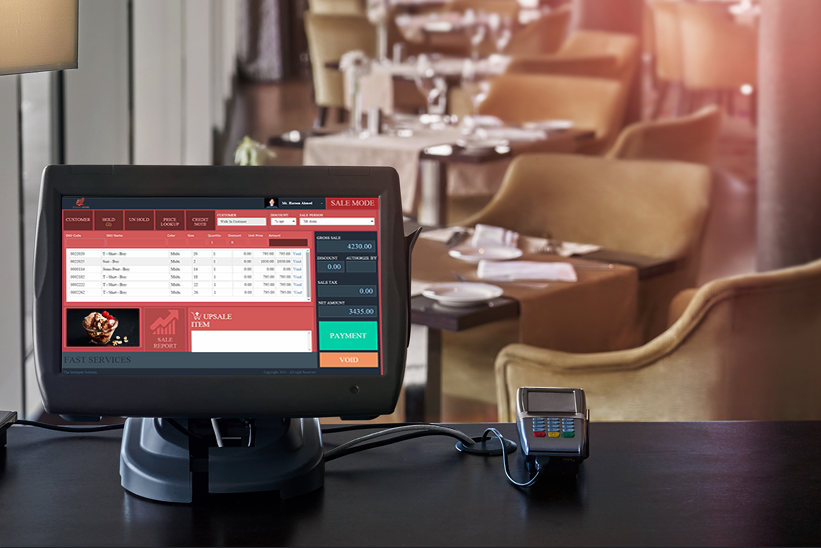In the fast-paced and competitive world of the restaurant industry, efficiency and productivity are crucial to success. One of the most significant technological advancements that have transformed restaurant operations is the Point of Sale (POS) system. POS systems have evolved from simple cash registers to comprehensive digital solutions that streamline various aspects of restaurant management. This article explores the critical role that POS systems play in enhancing staff productivity and efficiency in restaurants, ultimately leading to improved customer experiences and increased profitability.
Streamlining Order Management
One of the primary functions of a POS system is to streamline order management. Traditional methods of taking orders, such as handwritten notes or verbal communication between waitstaff and kitchen staff, are prone to errors and delays. POS systems eliminate these inefficiencies by allowing waitstaff to enter orders directly into a digital interface. The orders are then instantly transmitted to the kitchen display systems (KDS) or printers, reducing the chances of errors and ensuring that orders are prepared accurately and promptly.
By automating the order-taking process, POS systems enable waitstaff to focus more on providing excellent customer service rather than worrying about potential mistakes. This leads to faster service, happier customers, and increased table turnover, all of which contribute to higher revenue.
Enhancing Communication and Coordination
Effective communication and coordination between the front-of-house and back-of-house staff are vital for the smooth operation of a restaurant. POS systems facilitate seamless communication by providing real-time updates on order status, inventory levels, and special requests. For instance, if a customer has a specific dietary requirement or an allergy, the waitstaff can input this information into the POS system, and it will be communicated instantly to the kitchen.
Additionally, POS systems often include features that allow managers to monitor the flow of orders and identify bottlenecks in real-time. This visibility enables managers to make informed decisions, such as reallocating staff to high-demand areas or adjusting preparation times for certain dishes, to ensure that the kitchen operates efficiently and that customers receive their orders promptly.
Inventory Management and Cost Control
Effective inventory management is essential for minimizing waste and controlling costs in a restaurant. POS systems come equipped with inventory management features that track the usage of ingredients and supplies in real-time. When an order is placed, the system automatically deducts the corresponding quantities from the inventory. This not only helps in maintaining accurate inventory records but also alerts staff when stock levels are running low, allowing them to reorder supplies in a timely manner.
By providing insights into inventory usage patterns, POS systems enable restaurant managers to make data-driven decisions about menu planning, portion control, and supplier negotiations. This level of control helps in reducing food waste, optimizing inventory levels, and ultimately lowering operating costs.
Speeding Up Transactions and Reducing Wait Times
In a restaurant setting, the speed of transactions can significantly impact the overall dining experience. POS system are designed to process payments quickly and efficiently, reducing wait times for customers. Modern POS systems support multiple payment methods, including credit and debit cards, mobile payments, and contactless payments, making it convenient for customers to settle their bills.
Moreover, POS system can split bills, apply discounts, and manage loyalty programs with ease. These features not only enhance the customer experience but also reduce the time and effort required by waitstaff to handle complex transactions. As a result, staff can serve more customers in a shorter amount of time, leading to increased productivity and revenue.
Data Analytics and Performance Insights
Data is a powerful tool for improving productivity and efficiency in any business, and the restaurant industry is no exception. POS systems generate a wealth of data on various aspects of restaurant operations, including sales, customer preferences, peak hours, and employee performance. By analyzing this data, restaurant managers can gain valuable insights into trends and patterns that can inform strategic decisions.
For example, data from the POS system can reveal which menu items are the most popular and which ones are underperforming. This information can be used to refine the menu, introduce new dishes, or promote high-margin items. Additionally, performance data can help managers identify top-performing employees, recognize areas where additional training may be needed, and optimize staff scheduling to ensure that the restaurant is adequately staffed during busy periods.
Enhancing Employee Accountability and Motivation
Employee accountability is crucial for maintaining high standards of service and productivity in a restaurant. POS systems contribute to this by tracking individual employee activities, such as order processing, sales, and transaction handling. This transparency helps in identifying discrepancies and ensures that employees are held accountable for their actions.
Moreover, POS systems can be used to implement incentive programs that motivate employees to perform better. For instance, managers can set sales targets and offer rewards or bonuses to employees who achieve them. This not only boosts morale but also encourages employees to work more efficiently and provide better service to customers.
Simplifying Training and Onboarding
Training new employees can be time-consuming and challenging, especially in a busy restaurant environment. POS systems simplify the training and onboarding process by providing intuitive interfaces and user-friendly features. Many modern POS systems offer training modes that allow new hires to practice order taking, payment processing, and other tasks without affecting actual transactions.
Additionally, POS systems often come with built-in tutorials and support resources that employees can refer to as needed. This reduces the burden on managers and experienced staff who would otherwise have to spend significant time training new employees. As a result, new hires can become productive more quickly, reducing the overall training costs and improving operational efficiency.
Facilitating Remote Management and Monitoring
In today’s digital age, the ability to manage and monitor restaurant operations remotely is a valuable asset. Many POS systems offer cloud-based solutions that allow managers to access real-time data and reports from anywhere, using a computer or mobile device. This remote access capability is particularly beneficial for multi-location restaurant chains or for managers who need to oversee operations while away from the premises.
With remote management features, managers can track sales performance, monitor inventory levels, and even adjust pricing or promotions on the fly. This flexibility ensures that managers can respond promptly to changing conditions and make informed decisions to optimize productivity and efficiency, regardless of their physical location.
Reducing Paperwork and Administrative Tasks
Administrative tasks, such as generating reports, managing employee schedules, and handling payroll, can be time-consuming and detract from more critical operational responsibilities. POS systems automate many of these tasks, reducing the need for manual paperwork and administrative overhead. For example, sales reports, inventory summaries, and employee performance metrics can be generated automatically and accessed with just a few clicks.
By automating routine administrative tasks, POS systems free up valuable time for managers and staff to focus on more strategic activities, such as improving customer service, enhancing menu offerings, and driving business growth. This shift in focus leads to a more efficient and productive restaurant operation.
Ensuring Compliance and Security
Compliance with regulatory requirements and maintaining data security are paramount in the restaurant industry. POS systems help ensure compliance by providing accurate records of transactions, inventory, and employee activities. This is particularly important for tax reporting, health and safety inspections, and financial audits.
Additionally, modern POS systems are equipped with robust security features to protect sensitive customer and business data. Encryption, secure payment processing, and user access controls are some of the measures that safeguard against data breaches and fraud.
Conclusion
In conclusion, POS systems play a pivotal role in enhancing staff productivity and efficiency in restaurants. By streamlining order management, improving communication and coordination, optimizing inventory control, speeding up transactions, and providing valuable data insights, POS systems empower restaurant staff to work more effectively and deliver exceptional customer experiences. Moreover, these systems enhance employee accountability, simplify training, facilitate remote management, reduce administrative burdens, and ensure compliance and security. As technology continues to advance, the capabilities of POS systems will only expand, further revolutionizing the restaurant industry.
ALOXE Cosmetic Organizer Box Drawers Storage Plastic Stationary Box | Make Up Organiser For Women
₹199.00 (as of 7 November, 2024 18:26 GMT +05:30 - More infoProduct prices and availability are accurate as of the date/time indicated and are subject to change. Any price and availability information displayed on [relevant Amazon Site(s), as applicable] at the time of purchase will apply to the purchase of this product.)Odonil Room Air Freshener Spray - 440ml Combo (Pack of 2, 220ml each) | Lavender Mist & Jasmine Fresh | Nature Inspired Fragrance for Home & Office | Long Lasting Fragrance
₹199.00 (as of 7 November, 2024 18:26 GMT +05:30 - More infoProduct prices and availability are accurate as of the date/time indicated and are subject to change. Any price and availability information displayed on [relevant Amazon Site(s), as applicable] at the time of purchase will apply to the purchase of this product.)Claiez Wall Clock 12" Silent Quartz Decorative Latest Wall Clock Non-Ticking Classic Clock Battery Operated Round Easy to Read for Room/Home/Kitchen/Bedroom/Office/School,.
₹599.00 (as of 7 November, 2024 18:25 GMT +05:30 - More infoProduct prices and availability are accurate as of the date/time indicated and are subject to change. Any price and availability information displayed on [relevant Amazon Site(s), as applicable] at the time of purchase will apply to the purchase of this product.)XMART INDIA Drawer Organizers for Underwear, Socks, Bras, Ties, Undergarments, and Scarves - Closet Storage Dividers for Household Use Wardrobe Storage Box Set of 4 (Multicolor)
₹345.00 (as of 7 November, 2024 18:25 GMT +05:30 - More infoProduct prices and availability are accurate as of the date/time indicated and are subject to change. Any price and availability information displayed on [relevant Amazon Site(s), as applicable] at the time of purchase will apply to the purchase of this product.)CASPIAN /// Hike Stainless Steel Customize Sipper Water Bottle (CUS-Matte Black 1 Litre, Set of 1)| Leak Proof Thunder for Fridge Home Office Travel School Kids Boys Girls Adults Sports Gym Yoga
₹299.00 (as of 7 November, 2024 18:25 GMT +05:30 - More infoProduct prices and availability are accurate as of the date/time indicated and are subject to change. Any price and availability information displayed on [relevant Amazon Site(s), as applicable] at the time of purchase will apply to the purchase of this product.)Discover more from The General Post
Subscribe to get the latest posts sent to your email.





